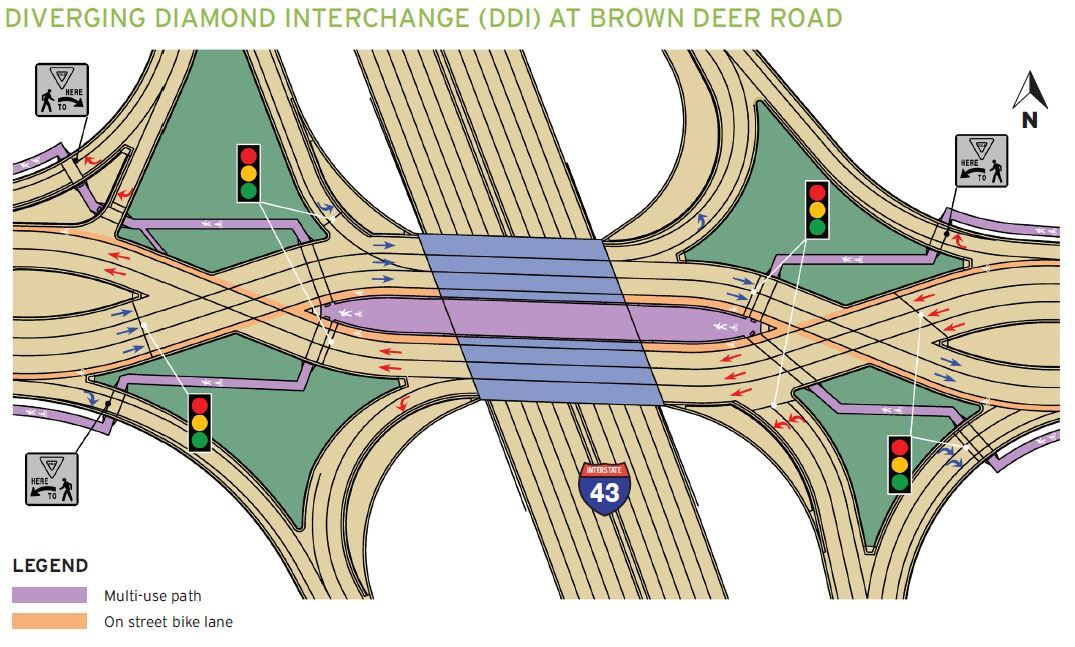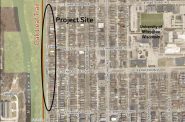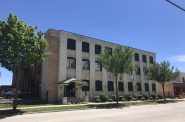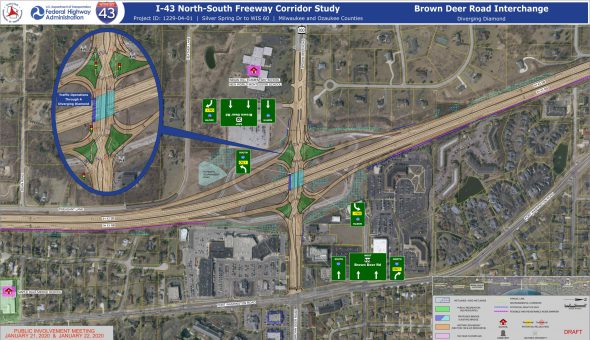I-43 to Get Diverging Diamond Interchange
Bicycle-friendly design has cars using left lane, a first for the county.

Brown Deer Diverging Diamond Interchange
The Brown Deer Road Interchange at I-43 is Milwaukee County’s only “Cloverleaf Interchange.” It dates to the freeway’s construction in the mid-1950s, when the surrounding area was rural, and land was cheap. Currently, traffic is some 80,000 vehicles daily, leading to congestion and crashes in what is now an urban high volume interchange, with levels expected to approach 122,000 by 2040.
In April, the Federal Highway Administration allowed a project to replace the interchange to proceed to final design and construction.
And what a design it is! The Wisconsin Department of Transportation (WisDOT) has proposed the county’s first “Diverging Diamond Intersection” or DDI, to replace the obsolete cloverleaf. According to WisDOT, “These interchanges have been shown to increase capacity and safety, decrease congestion and minimize the cost of new infrastructure.”
Also known as a “double crossover diamond,” the interchange eliminates pesky left turn issues by having traffic travel on the opposite side of the street, as if in Great Britain. Timed signals permit vehicles to cross from the right lanes to the left, and then cross back over after passing through the interchange. Driving on the left side of a two-way street in these parts has traditionally been the province of daredevils, drunks and desperadoes. With the interchange’s projected 2025 opening, it will now be available to law-abiding motorists.
Pedestrian and Bicycle Friendly
Unlike the current cloverleaf, which is hostile to all but vehicular traffic, the DDI provides considerable amenities for those traveling by other modalities. There will be dedicated bicycle lanes in the street, as well as a sidewalk, which will run in the middle of the bridge through the crossover area. It is also cheaper than traditional interchanges. An early project in 2009 in Missouri was budgeted at $10 million, but came in at $3 million. This will be the fifth such intersection in Wisconsin. The first, in Janesville, opened in 2016; another opened in Appleton in 2018, and two others are in the planning and construction stage.
Dan Sellers, the Southeast Region Communications contact for WisDOT, tells Urban Milwaukee of the cloverleaf design, “we don’t build them anymore. … This area has certainly changed a lot in the last 60 to 70 years. It’s very urban now.”
I asked if there were other intersections in the Milwaukee area that are proposed to have a diverging diamond intersection. Sellers responded, “Not at this time. There are other DDI’s that have already been constructed in the state, such as the WIS 11 interchange with I-39 / I-90, south of Janesville. It’s been operating very well.”
The DDI will also occupy a much smaller footprint, and I asked if the redesign of the interchange will result in excess land no longer needed for freeway use that might be put to other uses. According to Sellers, “Details are still being worked out, but there could potentially be an opportunity for this – the new ramps will be closer to the freeway than the existing ramps.” The current cloverleaf interchange is immediately west of the Riverpoint Village Shopping Center in Fox Point, and immediately east of the Milwaukee County Transit System Brown Deer East Park and Ride Lot in River Hills.
First DDI Was in Missouri in 2009
The American Diverging Diamond Intersection dates to graduate study in 2000 by Gilbert Chlewicki, an engineering student at the University of Maryland who had been inventing intersections since childhood. While on a European trip he was amazed to find that a similar interchange was successfully operating in France. This amplified his interest in seeing similar interchanges being built in America. The first was built in Missouri in 2009 and there are now 99 such interchanges operating in about half of all states. Chlewicki manages a website about the DDI.
Oh, and if you can’t quite picture how this interchange will work here is a Video Animation of DDI Traffic Flow.
If you think stories like this are important, become a member of Urban Milwaukee and help support real, independent journalism. Plus you get some cool added benefits.
Biking
-
Oak Leaf Trail Projects Could Start in 2024
 Jul 12th, 2023 by Graham Kilmer
Jul 12th, 2023 by Graham Kilmer
-
1896 Bicycle Factory Has Quite A History
 Sep 14th, 2021 by Michael Horne
Sep 14th, 2021 by Michael Horne
-
Honoring Biking Advocate Phil Van Valkenberg
 Jul 31st, 2021 by Spencer Black
Jul 31st, 2021 by Spencer Black
Plenty of Horne
-
Villa Terrace Will Host 100 Events For 100th Anniversary, Charts Vision For Future
 Apr 6th, 2024 by Michael Horne
Apr 6th, 2024 by Michael Horne
-
Notables Attend City Birthday Party
 Jan 27th, 2024 by Michael Horne
Jan 27th, 2024 by Michael Horne
-
Will There Be a City Attorney Race?
 Nov 21st, 2023 by Michael Horne
Nov 21st, 2023 by Michael Horne






















> Bicycle-friendly design
> Pedestrian and Bicycle Friendly
> the DDI provides considerable amenities for those traveling by other modalities. There will be dedicated bicycle lanes in the street, as well as a sidewalk, which will run in the middle of the bridge through the crossover area
These may be true compared to what exists today (and to other options the state would actually build), but crossing a DDI is not a good pedestrian experience. Pedestrians are both expected to cross multiple no-stop freeway ramps which are built for speed not safety, wait to cross two large signal-controlled intersections, and walk in the median of a loud high traffic road across the bridge.
It’s not much better for bikes. Bike lanes do not equal bike friendly, as bikes will still be expected to navigate two no-stop freeway ramps where drivers are going _much_ faster than the bikes and need to make a quick decision to merge across the bike lane. It is extremely unlikely that most drivers will be looking for bikes as they cross the bike lane. In my experience biking across other area freeway interchanges it is safer without the painted bike lane as I can take the full driving lane and be a bit more visible.
I don’t think this is not the only cloverleaf in the County. There is another at Silver Spring and Sherman.
There are some Wisconsin drivers who are still trying to figure out traffic circles. This interchange might really confuse them. Anyone driving the belt line of Interstate in the Twin Cities has experienced the clover leaf merging on two Interstates-a nerve-racking experience.
Sherman and Silver spring is NOT a freeway.
Kevin Germino,
The multi use paths tunnel UNDER the freeway ramps.
The latest fad from WisDOT. I ran into the Janesville one recently, not knowing what it was. I exited I-39 NB to go WB on Hwy 11 to enter Janesville. I had no idea what I had come up against. It is really confusing if you don’t have a picture. Making a left turn I expected to see EB traffic coming from the left, instead there was WB traffic coming from the right and I needed to turn right away. I couldn’t figure out where the EB traffic was until I had to stop at the light where the EB and WB lanes crossed.
Mingus, with all due respect, the Roundabouts are not part of any freeways and if people pay attention, a roundabout is rather easy to navigate. This interchange on a freeway would be similar to the rebuilding of the Marquette Interchange. In due time people will realize it is easier to navigate.
>>> The multi use paths tunnel UNDER the freeway ramps. <<<
While the included top-down-view line drawing might look like a tunnel, there are also clearly Yield signs on the diagram.
>> While the included top-down-view line drawing might look like a tunnel, there are also clearly Yield signs on the diagram.<<
You are correct, I misread. All of the crossing done by bikes and pedestrians are still on Brown Deer road before the acceleration ramps start and after the decceleration ramps end.
Wish I could edit instead of adding another comment. But here goes, this will be similar (not the same) as pedestrians crossing HWY 100 at Bluemound Rd, which I have done many times, each of the roads have a yield sign and cars need to watch for pedestrians.
Here is a good animation and article
https://azdot.gov/projects/central-district-projects/i-17-ti-reconstruction-happy-valley-rd-and-pinnacle-peak-rd/diverging-diamond-interchange
This interchange is but one part of a huge multi-year project to widen I 43 to three lanes from Silver Spring to Hwy 60. Highway lobby strikes again! More lanes are not needed; what is needed is to fix the existing pavement. More lanes equal more development in Grafton and North, more commuters working in Milwaukee County and paying taxes elsewhere.
Neither Sherman nor Silver Spring are freeways, but they DO meet at a full cloverleaf. It’s an example of over-building roads.
Michael, Would you kindly provide the budgeted costs and the final costs for the 5 intersections in Wisconsin, or at a minimum for those in Janesville & Appleton?
Seems logical to provide this much more relevant & timely information for 5 (or 2?) local projects constructed recently as opposed to an out of state project from 14 years ago.
…. And perhaps identity the “two others” that are in the planning & construction phase, along with their budgeted amounts & current projected final costs.
ps, I’m not dissing the projects, I’m simply curious because your piece explicitly steers to the conclusion that these projects are completed at 30% of the budgeted costs. ….Which likely occurs in FantasyLand, but honestly hard to fathom a DOT bridge contractor leaving 70% on the table….
… please prove me wrong, I’d cherish the fact that politicians tried to protect our money instead of their own cushy jobs…
See below…
“An early project in 2009 in Missouri was budgeted at $10 million, but came in at $3 million. This will be the fifth such intersection in Wisconsin. The first, in Janesville, opened in 2016; another opened in Appleton in 2018, and two others are in the planning and construction stage.”
In re beverly132: “working in Milwaukee County and paying taxes elsewhere.”
On more than a few occasions, I have expressed like comments. The litany of services (they go far beyond police and fire protection) that are provided to individuals who work in Milwaukee is endless. All of those services are paid for by the residents of Milwaukee at no charge to the non-resident wage earners.
A municipal, non-resident income tax would be more equitable and more encompassing than the recently approved sales tax.